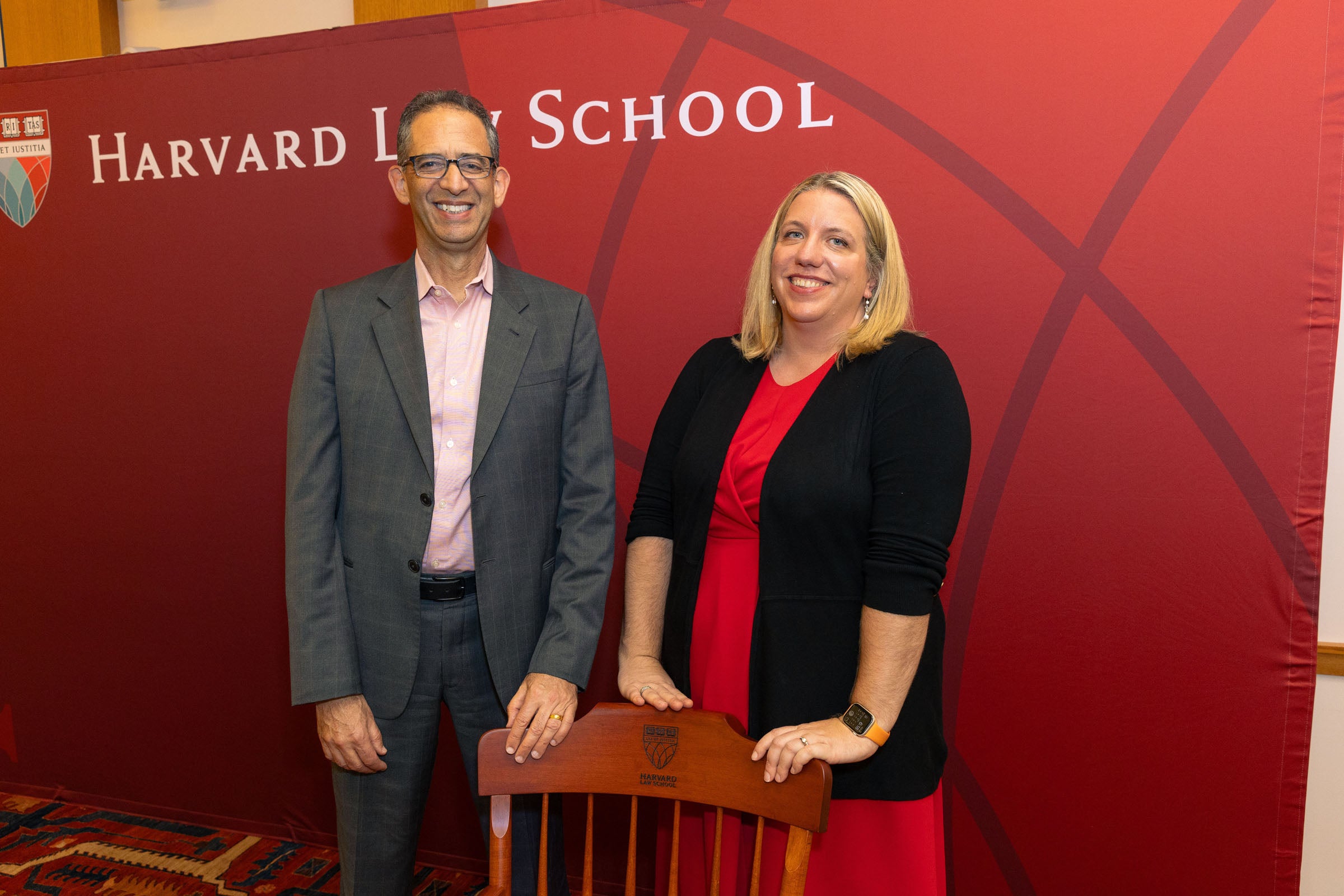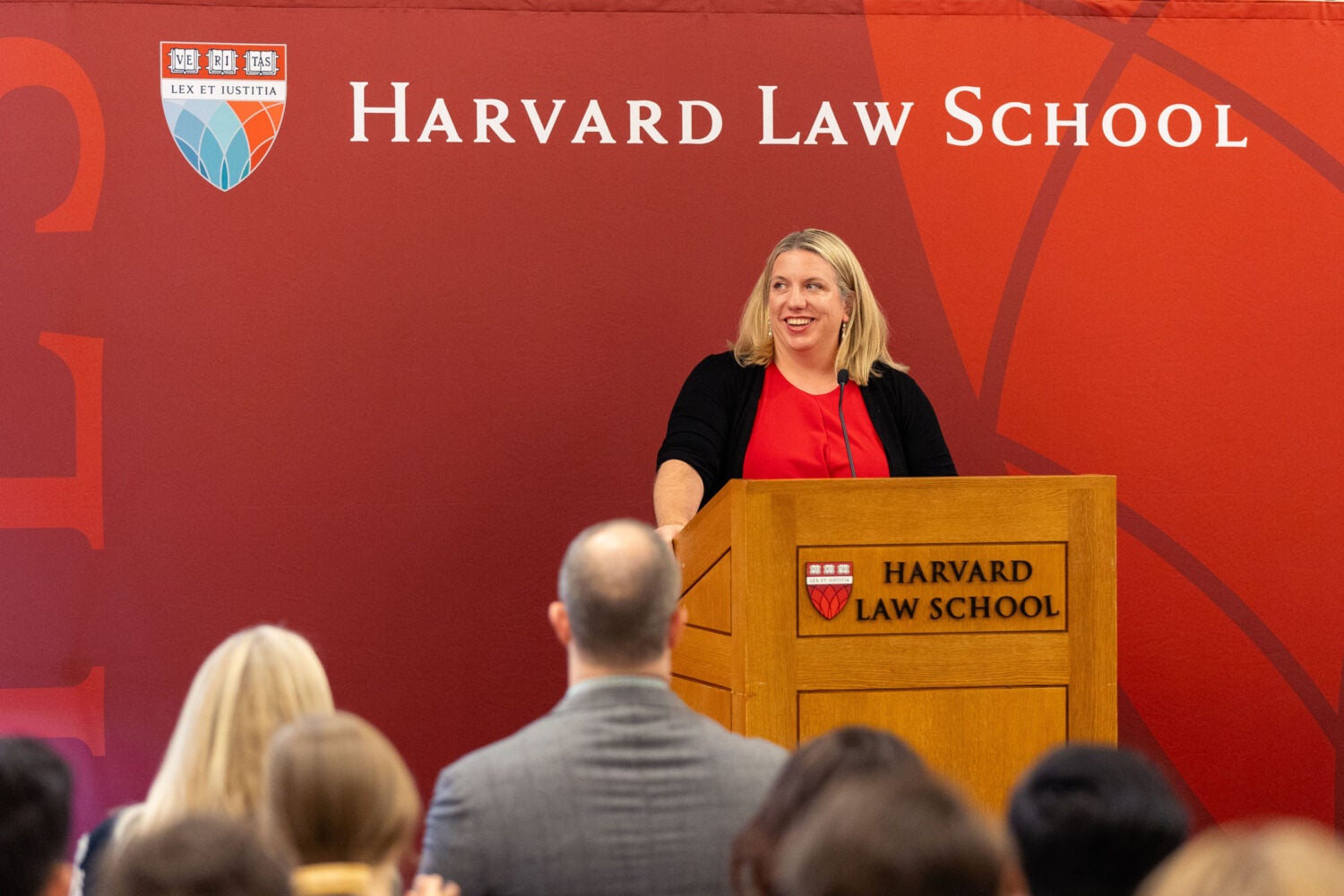The law helped create and protect exclusionary neighborhoods — and so, lawyers must be part of the solution to build better, happier communities, argues Harvard Law School Professor Maureen Brady.
In a lecture last week celebrating her appointment as the Louis D. Brandeis Professor of Law at Harvard, Brady described how 20th century reformers harnessed public and private law to restrict or even prohibit the building of multifamily housing in cities across the United States. But instead of fostering healthy families as they intended, “most of those plans were ultimately destined to destroy, rather than build, community,” she said.
In his introduction, Interim Dean John C.P. Goldberg praised Brady’s scholarship, teaching, mentorship, and forward-thinking leadership as a deputy dean at the law school. He added that, like Brandeis, the Supreme Court justice for whom her chair is named, she “bridges elegantly the sometimes-daunting divide between scholarship and practice” as “one of the nation’s foremost property law experts and a keen student of legal history.”
“Professor Brady, in all of her work, offers brilliant and subtle explorations of the ways in which property and property law shape the lives of people and communities,” he said.
After expressing gratitude for her colleagues, mentors, friends, and family, Brady confirmed that she saw the creation of community “as the central theme of not just my work in property, but also much of my life.”

She then outlined one of the central ways in which modern communities are organized — zoning, a planning tool used by local governments to designate certain land for specific uses. But zoning also contributes to some of today’s most pernicious problems, including the high cost of housing and even the rise in loneliness, Brady contended.
“It was wrong, in my view, for planners and their lawyers to use property and land use law to advance a substantive vision of the good,” said Brady. “Property and land use are instead at their best when they create both processes and physical places that generate social capital.”
Zoning emerged in the early 1900s in response to the “horrors of industrialization,” which had sometimes resulted in crowded, substandard housing and hazardous factories situated in residential neighborhoods, Brady said. “Zoning was in part a social experiment, an effort to engineer better communities through legal and urban design.”
“Property and land use are at their best when they create both processes and physical places that generate social capital.”
But to understand what went wrong, Brady said, one must look back several hundred years before the advent of planning, when British lawyers began inserting land use clauses into real estate sales contracts. These restrictions — initially simple things such as a requirement to maintain infrastructure — were an innovation, because unlike most contracts at the time, they would bind the buyer even after the sale closed, she said.
By the 1820s, these types of deed restrictions, also known as covenants, became fashionable in the U.S., Brady recalled. And as the nation’s suburbs ballooned, so too did the list of possible restrictions on property, which could include bans against housing people of certain races or classes. Deeds also began prohibiting multifamily buildings, Brady said, which people worried facilitated traffic, vice, and disease.

“The term ‘single family,’ which became synonymous with the uniquely American form of zoning, the single-family district, was battle-tested in contracts for many years before it ever appeared in a piece of legislation,” she noted.
Courts mostly upheld these deed restrictions and offered them even more legitimacy by applying them not only to the original buyer, but to all subsequent purchasers of the property, Brady said.
But when these individual efforts failed to completely halt “undesirable” land uses, such as apartment buildings, municipalities stepped in — and found a receptive public.
“Decades of cases about deed restrictions acclimated property owners to the idea of value-enhancing limitations, which they accepted as a matter of public law, as well as private,” she said. “On the social side, a variety of simultaneous developments helped to entrench the idea that something about multiple people living together was inherently harmful to the home that stands alone.”
“Decades of cases about deed restrictions acclimated property owners to the idea of value-enhancing limitations, which they accepted as a matter of public law, as well as private … On the social side, a variety of simultaneous developments helped to entrench the idea that something about multiple people living together was inherently harmful to the home that stands alone.”
New zoning regulations began proliferating from coast to coast, in part to protect exclusively single-family home neighborhoods, “where reformers believed families could produce and raise healthy children,” Brady said.
Their efforts are still reflected in the built environment today, Brady said. One study estimates that 75% of residential land in the U.S. is zoned solely for single-family detached homes. And courts have continued to uphold deed restrictions with no time limitations, leading to the rise of homeowners’ associations, which control the properties on which 75 million Americans live. This means that “both private and public law cooperate to prevent newer forms of housing,” Brady said.
In Brady’s view, these efforts have resulted in unchanging neighborhoods that divide, rather than unite. “The single-family district, especially in the suburb, tended to shred community, [because it] became easy to live one’s life remote from neighbors on isolated cul-de-sacs with no connection to the environment or the people that surrounded them.”
‘A political community striving toward good’
It is difficult to switch course now, Brady said, because, for many people, their home is their most valuable asset. “Individuals in most American towns and cities oppose change, not because they are attached to the people in their communities, but because they fear the value effects any change would have.”
But Brady was optimistic that property and land use law could — and should — address the problems they caused. Urban designers could do away with old rules that don’t make sense for today’s needs — such as parking minimums for new buildings that make construction more onerous or expensive. Improving processes, such as those used by homeowners’ associations or public hearings about land use matters, would allow more voices to contribute to planning decisions and “offer greater potential for the generation of social capital,” she said.
With respect to legal doctrine, Brady proposed revisiting and revising longstanding deed restrictions or city zoning plans, and “giv[ing] more credence to the customized over the standardized.” She also advocated for laws that “seek to force people transacting in property to be social, to ask around, get to know the neighborhood a little bit.”
After all, Brady said, property and land use law, as with other things in life, should aim to build community, not destroy it.
“The work of building community is hard. It involves a lot of grace and 1,000 minuscule decisions to be generous and be kind,” she said.
We need our neighbors, she concluded. “Not just to drag in the trash can when we’re away, but as fellow members of a political community striving toward good.”
Want to stay up to date with Harvard Law Today? Sign up for our weekly newsletter.
